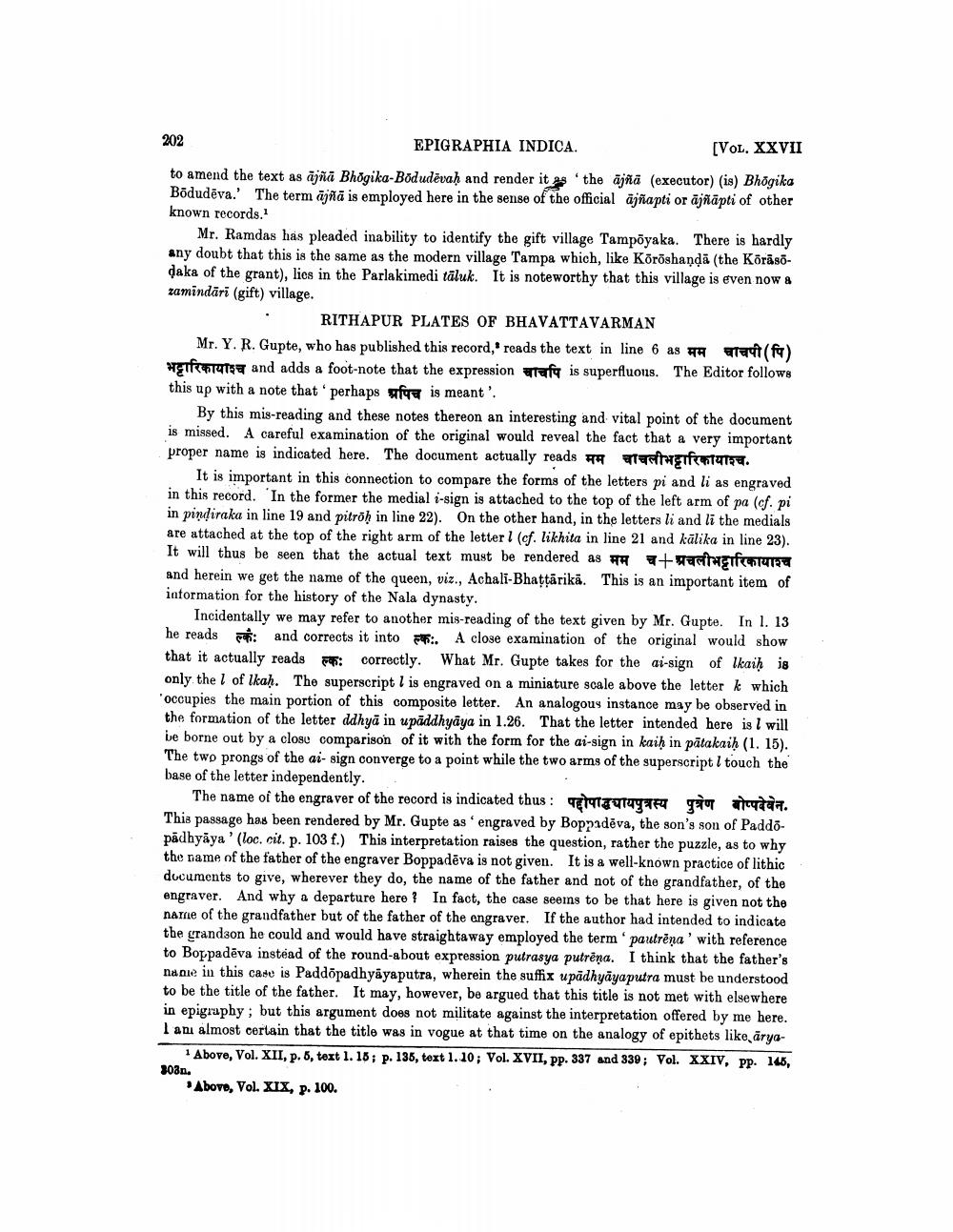________________
202
EPIGRAPHIA INDICA.
[VOL. XXVII
to amend the text as ajña Bhogika-Bodudevaḥ and render it as the ajña (executor) (is) Bhogika Bōdudēva.' The term ajñā is employed here in the sense of the official ajñapti or ājñāpti of other known records.1
Mr. Ramdas has pleaded inability to identify the gift village Tampoyaka. There is hardly any doubt that this is the same as the modern village Tampa which, like Kōrōshaṇḍā (the Kōrāsōdaka of the grant), lies in the Parlakimedi tāluk. It is noteworthy that this village is even now a zamindāri (gift) village.
RITHAPUR PLATES OF BHAVATTAVARMAN
Mr. Y. R. Gupte, who has published this record, reads the text in line 6 as
fats and adds a foot-note that the expression
this up with a note that perhaps fr is meant'.
(fa)
af is superfluous. The Editor follows
By this mis-reading and these notes thereon an interesting and vital point of the document is missed. A careful examination of the original would reveal the fact that a very important proper name is indicated here. The document actually reads मम चाचलीभट्टारिकायाश्च.
It is important in this connection to compare the forms of the letters pi and li as engraved in this record. In the former the medial i-sign is attached to the top of the left arm of pa (cf. pi in pindiraka in line 19 and pitroḥ in line 22). On the other hand, in the letters li and li the medials are attached at the top of the right arm of the letter 1 (cf. likhita in line 21 and kalika in line 23). It will thus be seen that the actual text must be rendered as मम च + श्रचलीभट्टारिकायाश्च and herein we get the name of the queen, viz., Achali-Bhaṭṭārikā. This is an important item of information for the history of the Nala dynasty.
Incidentally we may refer to another mis-reading of the text given by Mr. Gupte. In 1. 13 he reads and corrects it into. A close examination of the original would show that it actually reads: correctly. What Mr. Gupte takes for the ai-sign of lkaiḥ is only the l of lkah. The superscript is engraved on a miniature scale above the letter k which 'occupies the main portion of this composite letter. An analogous instance may be observed in the formation of the letter ddhya in upaddhyāya in 1.26. That the letter intended here is I will be borne out by a close comparison of it with the form for the ai-sign in kaiḥ in patakaiḥ (1. 15). The two prongs of the ai- sign converge to a point while the two arms of the superscript / touch the base of the letter independently.
The name of the engraver of the record is indicated thus : पद्दोपाद्धघायपुत्रस्य पुत्रेण बोप्पदेवेन. This passage has been rendered by Mr. Gupte as engraved by Boppadeva, the son's son of Paddōpadhyaya (loc. cit. p. 103 f.) This interpretation raises the question, rather the puzzle, as to why the name of the father of the engraver Boppadeva is not given. It is a well-known practice of lithic documents to give, wherever they do, the name of the father and not of the grandfather, of the engraver. And why a departure here? In fact, the case seems to be that here is given not the name of the grandfather but of the father of the engraver. If the author had intended to indicate the grandson he could and would have straightaway employed the term ' pautrēņa' with reference to Boppadeva instead of the round-about expression putrasya putrēna. I think that the father's nanie in this case is Paddopadhyayaputra, wherein the suffix upadhyayaputra must be understood to be the title of the father. It may, however, be argued that this title is not met with elsewhere in epigraphy; but this argument does not militate against the interpretation offered by me here. I am almost certain that the title was in vogue at that time on the analogy of epithets like arya
1 Above, Vol. XII, p. 5, text 1. 15; p. 135, text 1.10; Vol. XVII, pp. 337 and 339; Vol. XXIV, pp. 145,
303n.
Above, Vol. XIX, p. 100.




